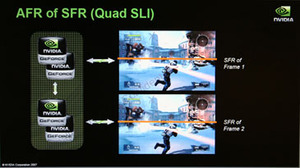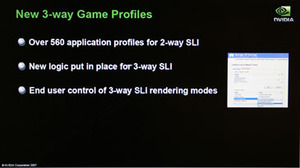First Look: Nvidia 3-way SLI on nForce 680i
December 13, 2007 | 14:01

More Detail on 3-way SLI rendering modes
Nvidia’s SLI technology uses any one of three different rendering modes, depending on how many GPUs are in your system. If you’re not familiar with the modes, we suggest you have a read of our original SLI and Quad-SLI DIY articles, as they help to explain the different rendering modes available.With Quad-SLI, there were four GPUs and the preferred rendering mode was AFR of SFR – this was down to the fact that DirectX 9.0 had a limitation where it could only render three frames into the backbuffer before they’re drawn on screen. Ever since Quad-SLI was introduced (and probably before too), Nvidia realised the shortcomings of split frame rendering and knew that alternate frame rendering was the way to achieve the best scaling.
As a result, Nvidia worked with Microsoft to implement a better algorithm for multi-GPU scaling that would allow more frames to be queued up ahead of time so that alternate frame rendering could be used over more than two GPUs. With Windows Vista, Nvidia says that it is now able to queue up to four frames in succession in both DirectX 9.0 and DirectX 10 with a new n-way AFR rendering algorithm, meaning that it will eventually be possible to see good scaling with Quad-SLI if Nvidia releases a driver for it.
This also probably helps to explain the reasons why Nvidia is only making the 3-way SLI driver available for Windows Vista. The other factor to consider is that most DirectX 9.0 games aren’t that intensive and the benefits of 3-way SLI (with the old rendering algorithms) could (potentially) be fairly limited.
While we're talking about Vista, Microsoft released a Windows Vista hotfix for multi-GPUs just last week, and that's something that Nvidia says you will need to install in order to get maximum performance in 3-way SLI. This patch probably enables the new algorithm if it wasn't already enabled in previous hotfixes -- details on the hotfix are pretty scarce.
At launch, Nvidia says that there will be around 70 applications supported and the company’s goal is to enable 3-way SLI support for all of the major games by the time it launches. That’s a big task in and of itself in my opinion, but Nvidia has seeded around 15 developers with pre-built 3-way SLI systems so that they can work to get their game engine working well with 3-way SLI.
I think this is something that AMD needs to do too if its CrossFireX solution is going to work, and more importantly, for drivers to be available on the day that major games launch. Seeding systems to developers may sound like a large initial financial outlay, but when you come to think of it the implications of this outlay will go a long way towards actually giving gamers the multi-GPU driver support that they need.
It’s one area where Nvidia has consistently done better than AMD in recent times as it works very closely with many of the world’s top game developers to make sure there is SLI scaling on the day the game ships.
Profiling is controlled in the same way as it is with 2-way SLI solutions, in that users can attempt to make their own profiles for games that don’t have a profile for 3-way SLI. However, as is the case with 2-way SLI and probably more so with 3-way SLI, don’t expect to yield massive performance increases when creating your own game profiles.
Based on what we’ve seen though, Nvidia’s intentions seem to be much more in line with its visions for conventional SLI solutions, which makes this a lot more attractive than... say, Quad-SLI. It’s as if Quad-SLI was a gremlin that Nvidia wants to beat, even though it could just walk away from scaling graphics performance across more than just two GPUs. Instead, it seems like Nvidia wants to prove to itself (and also its customers too) that it can scale graphics performance to more than two GPUs.

MSI MPG Velox 100R Chassis Review
October 14 2021 | 15:04












Want to comment? Please log in.